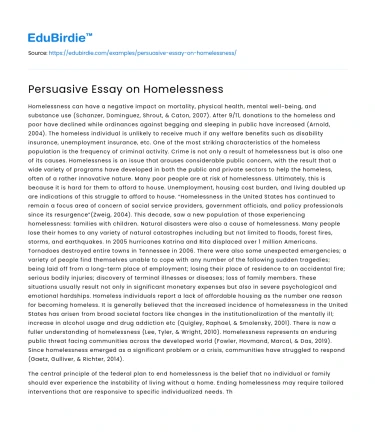Homelessness can have a negative impact on mortality, physical health, mental well-being, and substance use (Schanzer, Dominguez, Shrout, & Caton, 2007). After 9/11, donations to the homeless and poor have declined while ordinances against begging and sleeping in public have increased (Arnold, 2004). The homeless individual is unlikely to receive much if any welfare benefits such as disability insurance, unemployment insurance, etc. One of the most striking characteristics of the homeless population is the frequency of criminal activity. Crime is not only a result of homelessness but is also one of its causes. Homelessness is an issue that arouses considerable public concern, with the result that a wide variety of programs have developed in both the public and private sectors to help the homeless, often of a rather innovative nature. Many poor people are at risk of homelessness. Ultimately, this is because it is hard for them to afford to house. Unemployment, housing cost burden, and living doubled up are indications of this struggle to afford to house. “Homelessness in the United States has continued to remain a focus area of concern of social service providers, government officials, and policy professionals since its resurgence”(Zweig, 2004). This decade, saw a new population of those experiencing homelessness: families with children. Natural disasters were also a cause of homelessness. Many people lose their homes to any variety of natural catastrophes including but not limited to floods, forest fires, storms, and earthquakes. In 2005 hurricanes Katrina and Rita displaced over 1 million Americans. Tornadoes destroyed entire towns in Tennessee in 2006. There were also some unexpected emergencies; a variety of people find themselves unable to cope with any number of the following sudden tragedies; being laid off from a long-term place of employment; losing their place of residence to an accidental fire; serious bodily injuries; discovery of terminal illnesses or diseases; loss of family members. These situations usually result not only in significant monetary expenses but also in severe psychological and emotional hardships. Homeless individuals report a lack of affordable housing as the number one reason for becoming homeless. It is generally believed that the increased incidence of homelessness in the United States has arisen from broad societal factors like changes in the institutionalization of the mentally ill; increase in alcohol usage and drug addiction etc (Quigley, Raphael, & Smolensky, 2001). There is now a fuller understanding of homelessness (Lee, Tyler, & Wright, 2010). Homelessness represents an enduring public threat facing communities across the developed world (Fowler, Hovmand, Marcal, & Das, 2019). Since homelessness emerged as a significant problem or a crisis, communities have struggled to respond (Gaetz, Gulliver, & Richter, 2014).
The central principle of the federal plan to end homelessness is the belief that no individual or family should ever experience the instability of living without a home. Ending homelessness may require tailored interventions that are responsive to specific individualized needs. These factors make tackling homelessness a difficult task. Researchers, policymakers and advocates, and other stakeholders agree to the fact that the end of modern-day homelessness is achievable through an approach that will combine evidence, resources, innovative thinking, as well as political will. This is reflected in the United States’ first-ever comprehensive Federal Strategic Plan to Prevent and End Homelessness (U.S. Interagency Council on Homelessness, 2010). Many cities in the United States also have plans to end homelessness. Great strides have been made in recognizing homelessness as a solvable social ill, but much work is needed to realize the goal of eliminating homelessness. Now more than ever, we understand what strategies work to prevent homelessness, and communities across the country are doing their part to end homelessness. But we cannot let these efforts be hindered by stagnant wages, higher rents, and the whittling down of our safety net. There must be an investment in preventative measures such as expanding affordable housing and paying living wages that will prevent us from paying the higher costs associated with crisis interventions. Rectifying homelessness will require both attention to the structural roots of widespread dispossession and some measure of direct action (Hopper, 2014). The aim of the homeless policies of the last decade is not limited to the immediate goal of solving the problem of homelessness by eliminating the homeless (Feldman, 2006).
Save your time!
We can take care of your essay
- Proper editing and formatting
- Free revision, title page, and bibliography
- Flexible prices and money-back guarantee
California’s Department of Finance predicts that by 2030 the state’s population will reach fifty million people; twelve million more than today (Kroll & Singa,2008). Homelessness in California has grown dramatically since 1980, according to both formal and informal estimates (Dear & Wolch, 2016). California has the largest homeless population in the nation. The largest number of homeless people lives in Los Angeles, but homelessness affects most counties, even small and rural counties. Communities throughout California have been experiencing increases in the demand for homeless services. California has experienced an even more dramatic increase in homelessness than other parts of the nation. California’s increased unemployment, poverty, and foreclosure rates, as well as continuing high rental housing cost burdens, for this trend. Most homeless people in California are homeless simply because they cannot afford to house. California experiences multiple risk factors for high homeless rates: high unemployment, high housing cost burden, a high foreclosure rate (which correlates to high unemployment), lack of insurance, and significant housing overcrowding and doubling up. People facing significant barriers to housing stability who are homeless for long periods are unable to remain stably housed, even if given access to housing affordable to them. For these individuals and family members, disability, institutionalization, years of housing instability, and other factors make maintaining housing impossible.






 Stuck on your essay?
Stuck on your essay?

